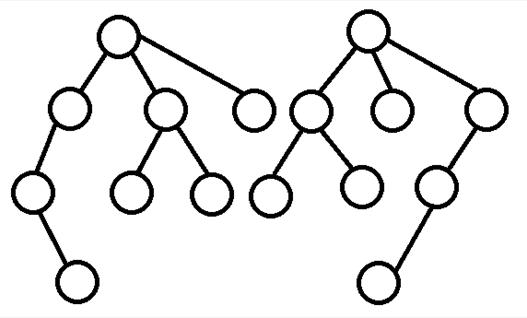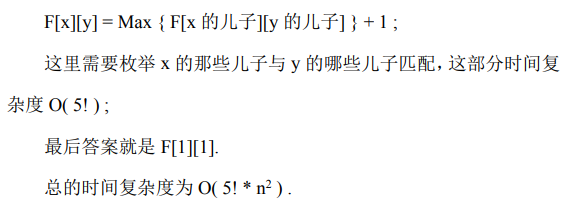Description
背景介绍
弗兰德,我不知道这个地方对我意味着什么。这里是一切开始的地方。3年前,还是个什么都没见过的少年,来到弗兰德的树下,走进了封闭的密室,扭动的封尘已久机关,在石板上知道了这个世界最角落的最阴暗的东西。那种事情,从未忘怀,从未动摇,我还记得,那一天,我,里修,第一次拔起了剑……
弗兰德的密室里,机关上方画着两棵树的字样,机关下方是一个有数字的刻度……
弗兰德最高的两棵树,只要知道两棵树的共同的相似度就行了……
给定两棵有根树,可以任意删除两棵树上的节点(删除一棵节点必须保证该节点的子树内的所有节点也必须要被删除,换一种说法,删除后的树必须联通并形成一棵树,且根节点不能被删除),使得删除后的两棵树同构,这两棵树有一个共同大小,即树的size,最大化同构的树的size即为机关的答案……
注:两棵同构的树要满足以下条件:
1、两棵树节点个数相等。
2、两棵树的以根节点的儿子为根子树对应同构。如下图,为两棵同构的有根树。
如下图,为两棵同构的有根树。

一行两个整数n,m分别表示两棵有根树的大小。
以下n-1行描述第一棵树,每行两个数x,y表示x号节点是y号节点父亲。
以下m-1行描述第二棵树,每行两个数x,y表示x号节点是y号节点父亲。
数据保证两棵树的1号节点均为根。
一行一个数,表示两棵树的相似度(删除后最大化的同构树的大小)。
3 3
1 2
1 3
1 2
2 3
2
【样例解释】
第一棵树可以保留1号节点和2号节点删除3号节点,也可以保留1号节点与3号节点删除2号节点,
第二棵树保留1号节点和2号节点删除3号节点。
剩下的树同构,树的节点个数均为2。
solution
一般没什么思路的就是DP了
f[x][y]表示第一棵树x节点与第二棵树y节点作为根节点时的最大同构
现在转移方程就很明显了

code
1 #include<iostream> 2 #include<cstdio> 3 #include<cmath> 4 #include<algorithm> 5 #include<cstring> 6 #include<queue> 7 #include<vector> 8 #include<stack> 9 #include<set> 10 #include<deque> 11 #include<map> 12 using namespace std; 13 14 template <typename T> void read(T &x) { 15 x = 0; int f = 1; char c; 16 for (c = getchar(); c < '0' || c > '9'; c = getchar()) if (c == '-') f = -f; 17 for (; c >= '0' && c <= '9'; c = getchar()) x = 10 * x + c - '0' ; 18 x *= f; 19 } 20 template <typename T> void write(T x){ 21 if (x < 0) putchar('-'), x = -x; 22 if (x > 9) write(x / 10); 23 putchar(x % 10 + '0'); 24 } 25 template <typename T> void writeln(T x) { write(x); putchar(' '); } 26 template <typename T> void writesn(T x) { write(x); putchar(' '); } 27 28 #define ll long long 29 #define inf 1234567890 30 #define next net 31 #define P 2147483647 32 #define N 1010 33 #define mid ((l+r)>>1) 34 #define lson (o<<1) 35 #define rson (o<<1|1) 36 #define R register 37 #define debug puts("zxt") 38 39 int n, m , xx, yy; 40 int f[N ][N ], book[N ]; 41 vector<int> ver1[N ], ver2[N ]; 42 void dfs2(int x,int y) 43 { 44 if(x >= ver1[xx].size()) 45 { 46 f[xx][yy] = max(f[xx][yy], y); 47 return; 48 } 49 dfs2(x + 1, y); 50 for(R int i = 0; i < ver2[yy].size(); i++) 51 { 52 if(book[i]) continue; 53 book[i] = 1; 54 dfs2(x + 1, y + f[ver1[xx][x]][ver2[yy][i]]); 55 book[i] = 0; 56 } 57 } 58 void dfs1(int x) 59 { 60 if(ver1[x].empty()) 61 { 62 for(R int i = 1; i <= m ; i++) f[x][i] = 1; 63 return; 64 } 65 for(R int i = 0; i < ver1[x].size(); i++) dfs1(ver1[x][i]); 66 for(R int i = 1; i <= m ; i++) 67 { 68 if(!ver2[i].size()) f[x][i] = 1; 69 else 70 { 71 xx = x; yy = i; 72 dfs2(0, 0); 73 f[x][i]++; 74 } 75 } 76 } 77 signed main() 78 { 79 //freopen("frand.in","r",stdin); 80 //freopen("frand.out","w",stdout); 81 read(n); read(m ); 82 for(R int i = 1, x, y; i < n; i++) 83 { 84 read(x); read(y); 85 ver1[x].push_back(y); 86 } 87 for(R int i = 1, x, y; i < m ; i++) 88 { 89 read(x); read(y); 90 ver2[x].push_back(y); 91 } 92 dfs1(1); 93 writeln(f[1][1]); 94 return 0; 95 }